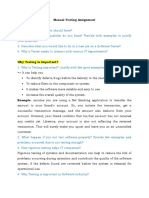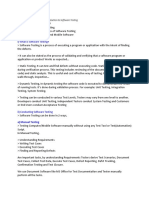0% found this document useful (0 votes)
8 views3 pagesManual Automation Testing Concepts
The document provides an overview of manual testing concepts, including types of testing such as smoke, sanity, and regression testing, along with a test case example for login functionality. It also outlines the bug/defect life cycle and differentiates between a test plan and test strategy. Additionally, it covers automation testing concepts, focusing on Selenium as an automation tool, its components, locators, and the Document Object Model (DOM).
Uploaded by
Shraddha BhosleCopyright
© © All Rights Reserved
We take content rights seriously. If you suspect this is your content, claim it here.
Available Formats
Download as PDF, TXT or read online on Scribd
0% found this document useful (0 votes)
8 views3 pagesManual Automation Testing Concepts
The document provides an overview of manual testing concepts, including types of testing such as smoke, sanity, and regression testing, along with a test case example for login functionality. It also outlines the bug/defect life cycle and differentiates between a test plan and test strategy. Additionally, it covers automation testing concepts, focusing on Selenium as an automation tool, its components, locators, and the Document Object Model (DOM).
Uploaded by
Shraddha BhosleCopyright
© © All Rights Reserved
We take content rights seriously. If you suspect this is your content, claim it here.
Available Formats
Download as PDF, TXT or read online on Scribd
/ 3




















































